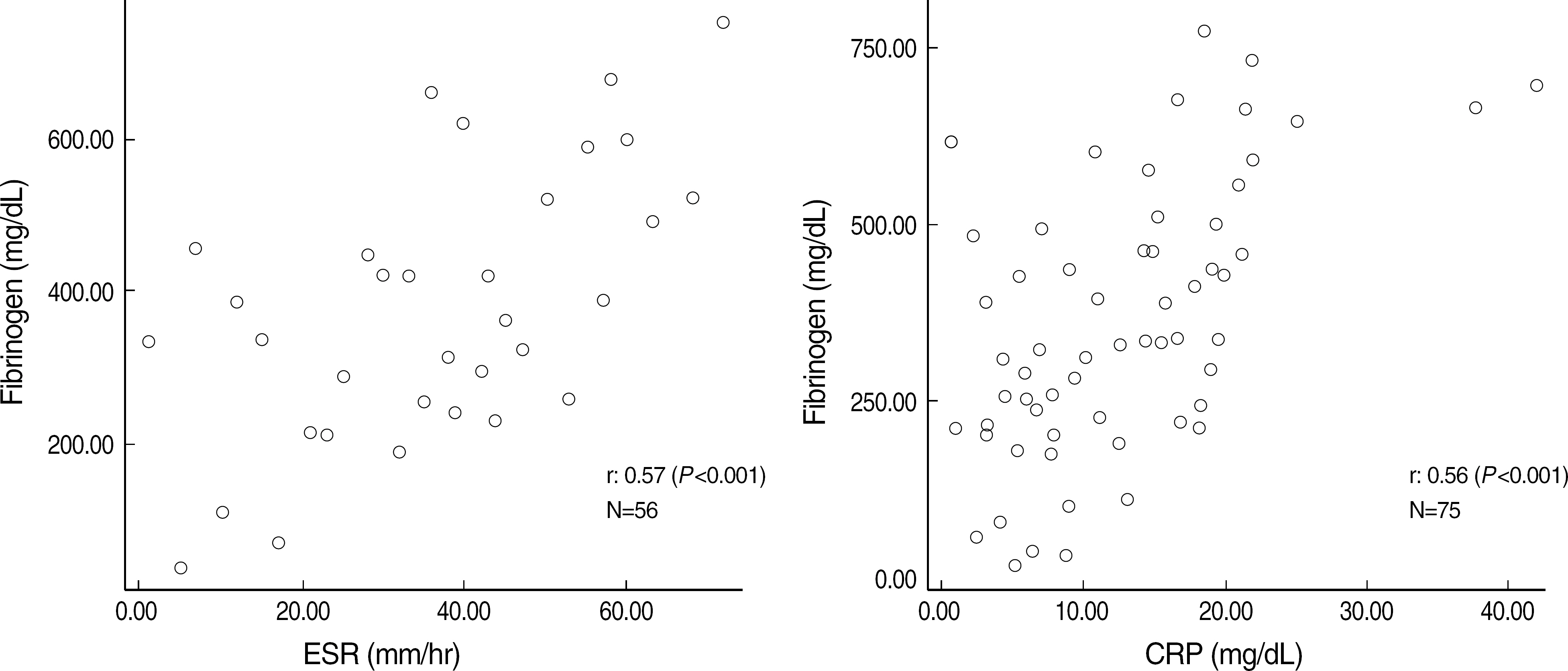Korean J Lab Med.
2007 Jun;27(3):157-161. 10.3343/kjlm.2007.27.3.157.
Investigation of Hemostatic Changes in Patients with Sepsis
- Affiliations
-
- 1Department of Laboratory Medicine, Kyunghee University, College of Medicine, Seoul, Korea. wileemd@hotmail.com
- 2Department of Internal Medicine, Kyunghee University, College of Medicine, Seoul, Korea.
- KMID: 1781477
- DOI: http://doi.org/10.3343/kjlm.2007.27.3.157
Abstract
- BACKGROUND: It is known that severe infection and inflammation lead to hemostatic abnormalities. Recently, much attention is focused on the mechanisms of infection or inflammation and on how it plays a central role in effecting the coagulation system. Disseminated intravascular coagulation in particular, is a common phenomenon in patients with sepsis, but the clinical implications of this condition are not clear. Therefore we attempted to evaluate the changes of the coagulation system in patients with sepsis and studied the factors that lead to such changes. METHODS: One hundred one patients diagnosed with sepsis were enrolled in this study. The patients were clinically evaluated for underlying disease and data for inflammatory status and coagulative changes were evaluated retrospectively. RESULTS: The WBC count increased in 76% and decreased in 6% of sepsis patients in comparison to the reference interval. The platelet count decreased in 65.3%. Changes in coagulative tests such as prothrombin time, activated partial thromboplastin time, antithrombin III, and D-dimer were observed in 70.4%, 52.7%, 87.2% and 100% of the patients, respectively. Correlation between ESR and fibrinogen was the highest in relation to the other coagulation factors. CRP also showed the highest correlation with fibrinogen in contrast to the other coagulation factors. CONCLUSIONS: This study confirmed the clear activation of coagulation in patients with sepsis. Of the evaluated factors involved in coagulation and fibrinolysis, fibrinogen showed the highest correlation to indices representing the inflammatory state. However further studies on the anticoagulant pathway are necessary in elucidating this matter.
Keyword
MeSH Terms
-
Adult
Aged
Aged, 80 and over
Bacterial Infections/diagnosis
Biological Markers/analysis
*Blood Coagulation
Blood Coagulation Tests
C-Reactive Protein/analysis
Disseminated Intravascular Coagulation/*diagnosis/etiology
Female
Humans
Inflammation/diagnosis
Male
Middle Aged
Platelet Count
Retrospective Studies
Sepsis/*blood/complications/diagnosis
Statistics as Topic
Figure
Reference
-
References
1. Levi M, Keller TT, van Gorp E, ten Cate H. Infection and inflammation and the coagulation system. Cardiovasc Res. 2003; 60:26–39.2. Dempfle CE. Coagulopathy of sepsis. Thromb Haemost. 2004; 91:213–24.
Article3. Lee HS, Byun SH. Early diagnostic laboratory tests of disseminated intravascular coagulation in newborn infants. J Korean Soc Neonatal. 1999; 6:78–84.4. Nah J, Park CJ, Chi HS. Quantitation of D-dimer, Thrombin-Anti-thrombin III complx and Prothrombin Fragment 1+2 in patients with disseminated intravascular coagulation and venous thrombosis. Korean J Clin Pathol. 1998; 18:35–41.5. Robert SM. Severe Sepsis and Septic shock. Kasper DL, Braunwald E, editors. Harrison's principles of Internal Medicine. 16th ed.New York: McGraw-Hill Professional;2004. p. 1606–10.6. Levi M, ten Cate H, van der Poll T. Endothelium: interface between coagulation and inflammation. Crit Care Med. 2002; 30:220–4.
Article7. Roberts HR, Monroe DM, Escober MA. Current concepts of hemostasis: implications for therapy. Anesthesiology. 2004; 100:722–30.8. Schleef RR, Bevilacqua MP, Sawdey M, Gimbrone MA Jr, Loskutoff DJ. Cytokine activation of vascular endothelium. Effects on tissue-type plasminogen activator and type 1 plasminogen activator inhibitor. J Biol Chem. 1988; 263:5797–803.
Article9. ten Cate H, Bauer KA, Levi M, Edgington TS, Sublett RD, Barzegar S, et al. The activation of factor X and prothrombin by recombinant factor VIIa in vivo is mediated by tissue factor. J Clin Invest. 1993; 92:1207–12.
Article10. ten Cate H. Pathophysiology of disseminated intravascular coagulation in sepsis. Crit Care Med. 2000; 28:9–11.
Article11. Esmon CT, Fukudome K, Mather T, Bode W, Regan LM, Stearns-Kurosawa DJ, et al. Inflammation, sepsis, and coagulation. Haematologica. 1999; 84:254–9.
- Full Text Links
- Actions
-
Cited
- CITED
-
- Close
- Share
- Similar articles
-
- Sepsis, Severe Sepsis and Septic Shock in the Elderly
- Sepsis and the current research of sepsis
- Endoscopic Hemostatic Treatment of Peptic Ulcer Bleeding
- Recent Developments in the Endoscopic Treatment of Patients with Peptic Ulcer Bleeding
- Difference in Bonding Strength of RMGIC according to Type of Hemostatic Agent in Primary Tooth


